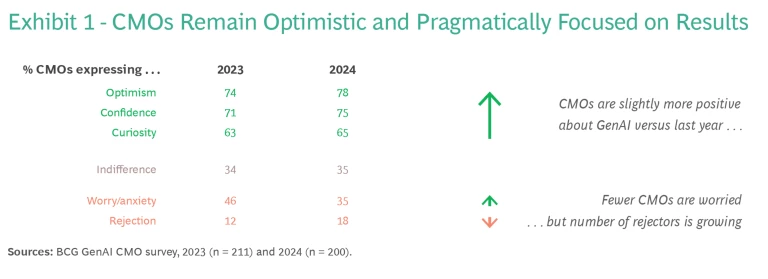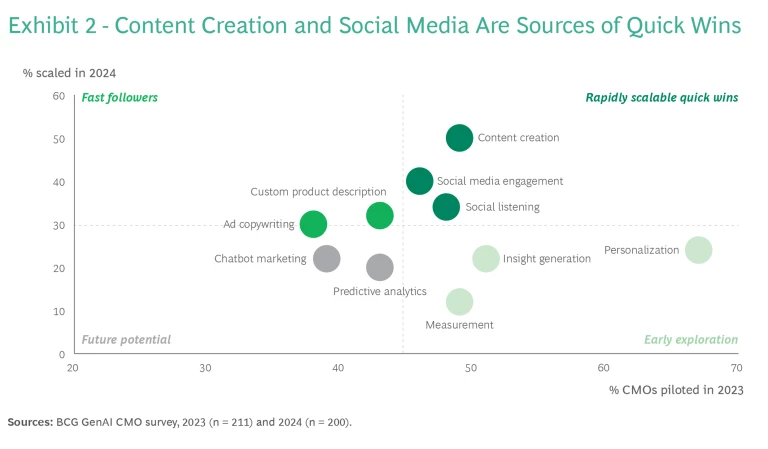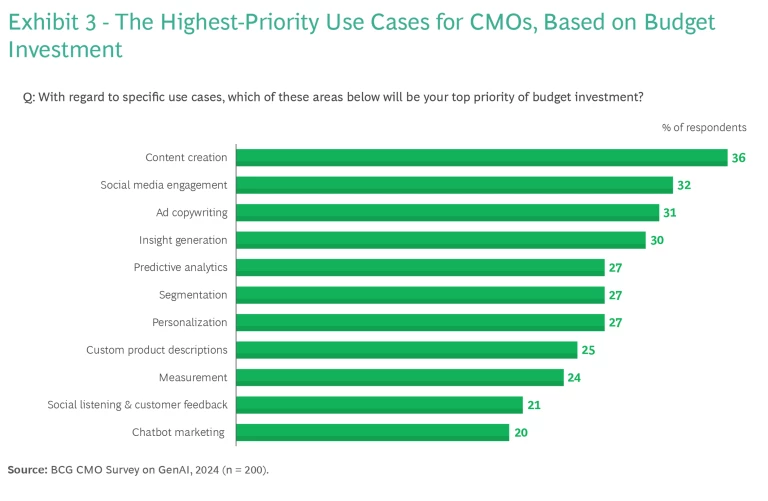CMOs are navigating a tough environment, balancing demands to achieve short-term improvements in marketing efficiency and effectiveness with long-term investments in digital transformations , tech stack upgrades, and AI adoption. Boards, CEOs, and CFOs are scrutinizing marketing’s overall contribution to performance and whether recent technology investments are paying off.
In the face of this pressure, many CMOs view GenAI as a tool to improve efficiencies and unlock growth. A majority of the respondents in our April 2024 survey of over 200 CMOs in 7 countries, conducted in partnership with the Association of National Advertisers (ANA), cited the adoption of AI or GenAI as one of their top five priorities over the next year. Around 80% said that GenAI is already improving automation, speed, and productivity. But the transformation is not progressing at the same speed for all, because it is exposing current shortcomings in the core operating models and data foundations that marketers will need to deploy GenAI at scale.
CMOs remain very optimistic about the promise of GenAI, as Exhibit 1 shows. In the year since our previous survey in April 2023 , however, their expectations have shifted from wide-eyed to pragmatic. They have identified the operational areas where they can scale GenAI initiatives rapidly and which initiatives will take longer to scale. They have learned firsthand where they can automate certain tasks to achieve step-change improvements in efficiency—and where human intervention will remain essential.

CMOs Are Balancing Ambition and Reality
CMOs are seeing a contrast between the ambitions of 2023 and the realities of 2024 as they get a better sense of what solutions they can deploy at scale. It seems that most CMOs have captured the low-hanging fruit of GenAI applications. Half of them are deploying GenAI tools for content creation, especially draft copy and images that marketers refine for social media ads. (See Exhibit 2.) Launching campaigns now takes hours instead of weeks, with improvements in engagement on the main platforms. CMOs are also using AI tools to enrich how they “listen” to social media. In contrast to earlier listening tools that mainly tracked sentiment and identified basic clusters of trends in posts, today’s AI tools are providing more immediate, specific feedback, with added data on variations across customer segments and contrasts to competitors.

As this rapid transition from experimentation to scale continues, the way that brands manage social media channels is likely to become the first area for real disruption in marketing. But to complete the journey, brands need to learn to manage lingering risks, such as how to avoid copyright infringement by properly implementing tools and ensuring that all content elements are sourced from preapproved libraries. Many of the operational aspects of social media will become automated and commoditized, but the increased volume of content might make it harder for a brand to stand out. That, in turn, will put more pressure on marketers to generate fresh creative ideas and increase the quality of the experiences that AI tools generate. In other words, efficiency will put more pressure on effectiveness.
In one example, a large direct-to-consumer pharmaceutical company made its content creation process 60% more efficient when it applied GenAI tools and made process improvements such as embedding creative resources on agile marketing teams and reducing the number of handoffs between teams. The largest efficiency gains came in creative brief writing and in the image-, copy-, and video-generation steps. Applying GenAI also accelerated quality control and compliance approvals. Automated dashboards flagged outliers and potential conflicts with brand guardrails, which themselves became better refined and clarified through this work. The new content ultimately doubled the ROI of the company’s social media advertising spend because the firm chose to reinvest the freed-up resources into creating more personalized content for its brand campaigns and better tailoring them to individual channels and customer cohorts, instead of cutting costs.
Personalization Will Require a Step Change
Successes in personalization fueled by GenAI are not yet as widespread. Personalization was the most common experimental use case in our 2023 survey, but CMOs have since learned that it is among the harder use cases to deploy quickly at scale. The operative word is “quickly.” GenAI tools can help create the necessary content variation for personalization, but it takes predictive AI to know what action to take next with each customer, and therefore what content is appropriate, in what sequence, and in which channel.
GenAI can help create the necessary content variation for personalization, but it takes predictive AI to know what action to take next with each customer.
An organization builds that intelligence through constant testing, learning, and refinement by feeding machine-learning models with a nonstop flow of data. The process yields a richer, more granular understanding of what it takes to change the behavior of each customer. Marketers also need to rethink how to conduct testing, because their dominant operating approach—running campaigns and periodic promotions—doesn’t generate the data needed to inform a personalization engine. Instead, they need small agile teams running constant experiments to move fast and build the scale of learning.
In our recent research, we have established a new way to measure personalization maturity, which we call the Personalization Index. Personalization leaders—the 15% of companies that scored highest on the index—have often gone through a multiyear change journey. They achieve quick wins to fund investments in the first year, then make further AI and tech investments and implement operating model and governance changes that drive larger shifts in their organizational structures and incentives over the medium term.
The work is difficult and time-consuming, but our experiences with leading clients confirm that personalization at scale offers the greatest upside from the adoption of GenAI. Companies are increasingly competing on the volume of quality interactions with customers and the speed with which they learn from them and make them better. Personalization is the ultimate way for a company to unlock growth from AI, instead of only focusing on efficiency.
Bland Puts Brands at Risk
GenAI has had its greatest impact thus far on internal processes: better speed, higher productivity, and less manual labor. In terms of content quality, however, CMOs now have firsthand proof that GenAI content can be bland or unimaginative. Over 70% are concerned about GenAI’s impact on creativity and brand voice, two domains in which humans continue to outperform algorithms. In the supplementary interviews we conducted, CMOs said they are challenging their teams to maintain their focus on creativity and emotional connection as they move toward tools that do a better job of incorporating brand voice.
To achieve these goals, about half of our respondents said that they are hiring talent with GenAI-specific skills. In addition to having the right talent, they will also need to change their ways of working. Cross-functional, agile teams will allow them to move quickly and maintain the focus on creativity.
Mastering the Shift from Automation to Innovation
CMOs are optimistic about the impact of AI and GenAI on their topline growth and are investing accordingly. Over half of survey respondents are projecting at least 5% topline growth in their GenAI-related business cases, and three out of five will invest at least $10 million annually in AI and GenAI initiatives over the next three years.
To ignite this growth, however, CMOs will need to find a way to focus on innovation with GenAI and not concentrate solely on automation. Currently, they are investing primarily in low-hanging fruit (content creation, social media engagement, and ad copywriting). (See Exhibit 3.) But to get the most from GenAI, they must shift their priorities to strategic areas such as customer insight generation, personalization, segmentation, and predictive analytics.

Our recent work with a large consumer packaged goods company revealed the power of applying GenAI to these areas. Marketers and product designers mined insights in hours, generated new product concepts in days, and tested them with synthetic focus groups in a week; the traditional process would have taken four months. The concepts also tested better on average than those developed with the traditional process, and these test results were validated by real-world focus groups conducted subsequently to confirm the power of this approach. Applying these approaches will require large cross-functional changes to the product development process, but the payoff in growth is promising.
CMOs Are Shaping the Transformation
CMOs are adopting GenAI with a bottom-up approach originating within business units instead of using a coordinated approach across the entire organization. As a result, they are collaborating most often with data and tech executives such as the CTO, CDO, or CDAO and less with the broader business leaders such as the CEO, CFO, or CHRO. Three out of five CMOs say they are the driving force behind the funding and investment for GenAI. We believe the full organizational transformation will take hold once the broader business functions see the impact and become more engaged.
Three out of five CMOs say they are the driving force behind the funding and investment for GenAI.
Over the past decade, many marketing organizations have become increasingly chopped up into specialists. This forces more handoffs, makes coordination tougher, and limits career advancement options. AI has the power to change this structure by essentially providing every worker with a virtual assistant that can take out the toil and increase the joy of the work while also unlocking more opportunities for a worker to use available data. Armed with these expanded capabilities, marketing team members can broaden their skills, expand the scope of their work, and accomplish more in closer-knit teams.
It’s no surprise, then, that most CMOs have focused on capturing efficiencies in their own function in the first 18 months of their GenAI journey. The next steps in the transformation, however, will bring significant change and disruption. As they capitalize on GenAI, and AI in general, CMOs will need to show the enterprise that they themselves can transform how work gets done and be the beacon for others.
Methodology: BCG and ANA jointly surveyed 200 CMOs based on BCG’s GenAI survey methodology in April & May 2024.









